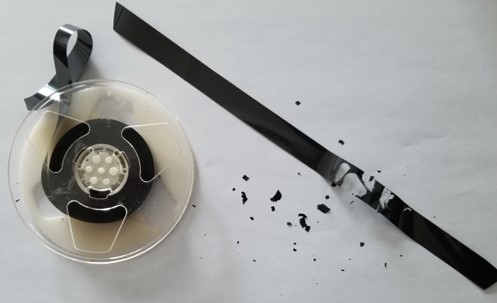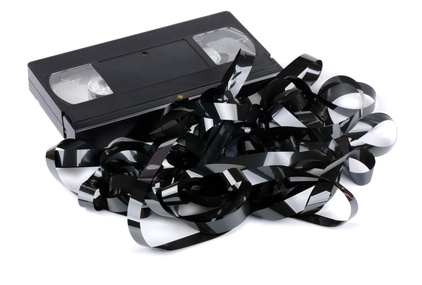- Home
- Damage and Repair
VHS Repair
VHS repair is sometimes required to play VHS tapes so that they can be properly digitized. How to fix VHS tape depends on the specific problem with the tape.
With VHS cassette tapes there are usually three main problems that prevent the video tapes from playing properly. These problems are: chemical degradation of the tape binder; physical damage to the tape; damage to the cassette shell.
Chemical Degradation of Tape Binder
A VHS video tape is composed of a plastic base with a binder or polymeric substance that has magnetic particles in it. The magnetic particles are what store the video information. The binder protects the magnetic particles and holds them onto the base. Unfortunately, over time, due to the action of poor storage under warm and humid conditions, the binder can chemically degrade. When this occurs, the tape can become sticky and be difficult to play. The binder may also not hold together very well and begin to flake off the base taking magnetic particles and video information with it.
The image below illustrates this effect. Because of binder degradation, pieces of binder and magnetic material have fallen off a strand of VHS tape, leaving behind a clear section of plastic base.

The VHS repair for this problem is baking. Baking involves exposing the tape to carefully controlled warm and dry conditions (less than 50 degrees C) for several hours. This repair method has had success, but only experts familiar with this technique should attempt to bake video tapes or any other type of magnetic tape. Utilizing this method to fix VHS tape without having any previous experience with the technique, results in a large probability or destroying the tape completely. Consult a VHS tape repair expert to be safe.
VHS Repair - Physical Damage to Tape
Physical damage to VHS tape can be caused by a damaged cassette, dirty and misaligned equipment, poor tape handling, and storage of tape in a poorly wound state. Physical damage includes scratches, wrinkles, and breakage.

VHS repair for wrinkles generally involves cutting out the section of wrinkled tape and using the appropriate slices and splicing equipment to attach the good ends together. To fix broken VHS tape, this same technique can be used. Do not use adhesive tape or similar products for the VHS tape repair. Use only splices designed for video tape repair. A splicing block allows the tape to be properly cut so that the splice is smooth. A rough splice can damage the video heads in the VCR.
If the wrinkled portion requires saving, applying low heat to the wrinkled portion of the tape sandwiched between Teflon with pressure applied to the base side of the tape (not the binder side) with an iron on the low setting might smooth out the tape. This is a risky and somewhat experimental VHS repair and use only with caution.
This is no VHS tape repair for scratched tape. Scratching can lead to magnetic particle loss and loss of recorded information. Playing scratched tapes can also contaminate and damage the playback equipment.
Damaged Cassette Shell
A damaged cassette can physically damage the tape. The VHS repair is to change the cassette housing. To fix VHS tape with this problem, it is a good idea to replace the damaged cassette with the same type if possible. This process can be a little tricky because of all the little parts found in the cassette shell. Practice with a worthless cassette first before transferring the good tape to the new cassette shell. If this VHS tape repair is too complex, then consult a tape repair specialist.